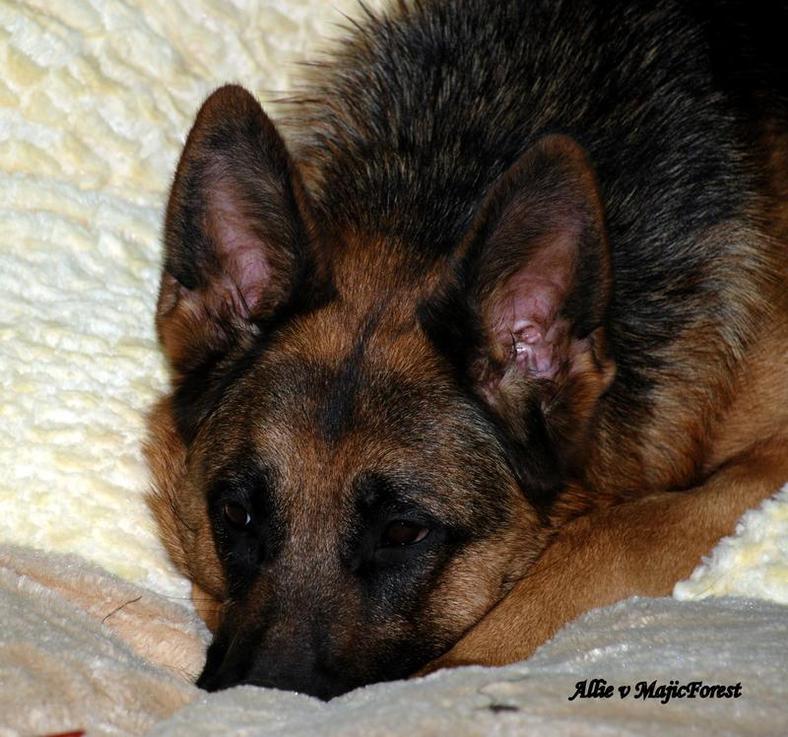German Shepherd Breeder
Puppy Aptitude Testing at 49 Days Old - Edie Schoepp
Most people are curious about the reason for puppy aptitude testing. The testing that I use is to help identify weaknesses and strengths in each puppy. When these are evaluated, it is used to determine what pup is right for which home. This information is very helpful when training and socializing the pup and can help a breeder with good information as to trends in what they are producing.
If we can identify weaknesses in a puppy, those are the things that can be worked on right away to make the puppy strong and more stable. The training you do first 6 months is critical to the pups success. With a German Shepherd plan on pretty hard work the first couple of years to get a good family pet!!
Herding breeds make lots of mistakes with their MOUTHS!! (that is part of trouble!!) Ideally what we would like in a pet puppy, is one who tests right down the middle. Not too high or too low, not too soft or too hard.....you get the idea!! Also remember that puppies go through all kids of stages where they may get fearful for a time. They also go through changes with hormones. If a puppy is kept intact, Training can be more difficult with hormone swings.
The testing can get very detailed and depending on the tester and what they know. Books can and have been written on what a tester sees!! I do believe in puppy testing. My last 3 dogs that I have were from puppy tested litters and they are how they tested!! The test I use was developed by Mary Ann Normann of Blue Star Dog Training in Cleveland Ohio. She has German Shepherds ! I have known her for 28 years.
Here is a quick brief of what is done in the aptitude testing and basically what it means:
Social Attraction: the pup is carried into a room they have never been in by the tester. (me) The pup is put down and I go to the center of the room and kneel down. The pup is watched to see how they react. Ideally they look around and come over to the tester. Since we are talking about German Shepherds we won’t expect them to act like Golden Retrievers, but I would like for the pup to see me and come over with a little tail wag. Some pups freeze, some come and get excited and nip/jump, some kiss you on the face, some don’t come at all.
Social Dominance: While still on my knees I pet the puppy very heavily with both hands. I want to see how the puppy reacts to the pressure. Do they get excited and nip and growl, lick, roll over, jump, freeze, go away? Does the puppy get excited and crank up? Ideally I would like a pup to look at me and maybe try to lick my face or give me some eye contact. I don’t want a puppy who wants to leave and get away from the pressure.... ! I want one that hangs in there and stays calm. Important for a family with kid.
Following: Next I start to walk the room in a big circle to see if the puppy follows me. Ideally I would like to have the puppy follow me but also explore the environment as we go. That shows me some confidence in the pup. Some don’t follow at all, some leave, some freeze, some bite on pants or get under foot. The pant leg biters can sometimes be the pups with high prey drive or some nervousness. Some leg biters are doing that because they are still cranked up from the petting!! I love for a puppy to try to give some eye contact when they follow. No pant leg biters for homes with kids!! Most puppies do that at some time anyway!
Restraint: The pups is gently rolled over on their back. Ideally I would like to see a pup who is pretty accepting. They might squirm a bit but can CALM down!! I also like to see just a little soft eye contact. Pups will, scream, bite, squirm, struggle, flail. I can usually tell how much restraint the mother has done with the puppies. Some accept this really well and some even panic. If I have a super tough puppy who really fights the restraint badly I might not want that pup in a home with kids. On the other hand I don’t want the pup who is too soft and has trouble dealing with the kids either.
Retrieving: I get the pups attention with a small soft ball and then roll it away from the pup. Ideally I would like to see a puppy who follows the ball and then comes back with it. I do encourage the pup to come back. I also like for the puppy to be able to release the ball to me. This will tell me something about the prey drive of the pup. Also if the puppy is a team player. Some pups take the toy and go away and want to keep it. It might tell us something about the pup being possessive. Some pups suck that ball back into their mouths and will not let you take it. Watching for tough, high prey dogs is important when looking to place with kids. the toy and go away and want to keep it.
Sound Sensitivity: With the pup across the room a metal chain is dropped into a metal bowl.We want to look for a dog that is sensitive to the sound. A normal puppy will startle. I then want to see if the puppy will come over and see what made the sound. Do they turn and start coming on their own??Will they come with coaxing? I want to see how well the puppy recovers and if they TRUST me to come and investigate. There are some puppies who are extremely sounds sensitive and have lots of trouble. That is one thing that can be worked on but may show itself later in life.....dog scared of fire works, thunder storms, etc.
Sight Sensitivity: A furry rag on a string is drug along the floor in front of the puppy.We want to see if the puppy chases, pounces, grabs, barks, lowers the tail, runs, attacks the rag. I would like to see a pup who is curious and wants to investigate.With a shepherd we usually see some interest in grabbing the rag. This is one I really watch closely when it comes to kids. I am careful with the puppy who attacks the rag, likes to shake it and growl and not let go. I also am careful if a home has cats, small dogs, etc. That may be a dog that is very prey driven and determined. Might not be the best with kids or with a large pack of many animals.
V-Gate: This is a V shaped gate I put the pup behind and then run away. I want to see how the puppy solves the problem of getting out and if they run to me. Some look and get around the side, some knock it down, some get out and run but then not to me! I also note if they seem calm in solving the problem or show any fear or panic.
Mirror: The puppy is picked up and taken over by a mirror and set down.We want to see how the puppy approaches the pup in the mirror. Does the pup sweetly drop the tail and go to lick/kiss the mirror? Do they pop up their tail and get stiff?We want the pup that will give a nice low wagging tail with kisses to the other puppy. Some will bark and growl. This is the test that shows how social the pup is with a strange dog and how they deal with them.
Ramp: We have a box with a slanted ramp going down for the pup to be put on. I coax the pup to come down the ramp toward me. Ideally I want to see a puppy TRUST me and try to come down. Pups will, freeze, try to jump off, whine, etc. It is nice to see how many of the pups know how to use their bodies
Touch Sensitivity: I hold the pup in my arms and gently pinch their skin between the toes. Some pups react right away and some are very tough. Some pups go stiff and don’t react. It tests how physically tough the puppy is. If I have kids in the home I want a pup that can take some rough handling and survive. Even with kids that are very good with dogs a tail gets stepped on, dog gets poked, etc. We don't want a super soft dog to go to a family with lots of kids either ! On the other hand a super tough dog can be hard to train if they are physically tough and determined. poked, etc. We don’t want a super soft dog to go with a family with lots of kids either! On the other hand a super tough dog can be hard to train if they are so physically tough and determined.
Food: I take a piece of food and present it to the puppy. This looks at how food driven the puppy is. Some pups are over the top on food and need to learn to be calm around it. Some lick at the food, and some grab and bite. Some have no interest. I like to note if I have a very grabby food pup. In a family situation we want to make sure the pup will let the kids take food, bones, toys away and not get possessive !
The descriptions I have given are VERY basic. There is so much detail that goes with the puppy testing. For anyone who has a chance to watch they are amazed by what is seen in the test, and how different each puppy is. So....the goal is to get the puppy in the home that it will fit the best with. The information on the test may help the family know what they need to work on. Of course if we have homes who have experience German Shepherds, they may be familiar with how to work with these behaviors because they have seen them before !!
Copyright 2011 Majic Forest Shepherds: Long Coat German Shepherd
Breeders. All Rights Reserved (801) 473-3477



